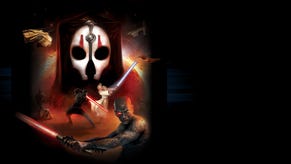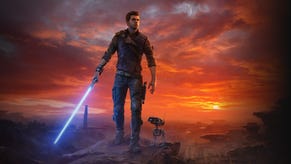Before Rogue One: When Games Were Filling in the History of Star Wars
The veterans who worked on X-wing remember when Star Wars was still a relatively blank canvas.
This article first appeared on USgamer, a partner publication of VG247. Some content, such as this article, has been migrated to VG247 for posterity after USgamer's closure - but it has not been edited or further vetted by the VG247 team.
It's hard to imagine now with the constant din of new movies, games, and comics, but there was a time when Star Wars was very much on hiatus. In the early 1990s, the media machine that had dominated the late '70s and much of the '80s had more or less ground to a halt. George Lucas had mostly moved on to other projects; the toys had stopped, and new media was confined to comics and the odd book. While it wasn't completely finished, its output was definitely at low ebb.

David Wessman was among those who had more or less stopped paying attention to Star Wars in 1992. A 31-year-old tester at LucasArts, he had made his way to Larry Holland's studio through Secret Weapons of the Luftwaffe: the World War II flight sim that would later serve as the basis for the X-Wing flight sims. These days Wessman is a lead designer on Starfighter Inc., a spiritual successor to the space combat flight sims of old, as well as an international game design and architecture lecturer at NHTV Breda University of Applied Sciences in the Netherlands.
He remembers the atmosphere around Star Wars being quiet, "There was an arcade game, and... there was at least one console game. Because [LucasArts] didn't want games being made with the Star Wars or Indiana Jones license, they wanted new stuff, and they were willing to lose money."
In this environment, there were only a few movies to work from; the novels were only just getting started, and the prequels were still years away. There was a tremendous amount of room for an enterprising creator to define the Star Wars universe.
And that's just what the team behind X-Wing did.
Filling in the Gaps
LucasArts was new to the Star Wars license in 1992, having just acquired it from Broderbund. Larry Holland, an independent contractor who had built the Secret Weapons of the Luftwaffe games for LucasArts, saw it as an opportunity to repurpose his World War II flight sim engine for Star Wars. It was a perfect fit given that Star Wars was originally based on old footage of World War II aerial battles. The game he came up with was X-Wing: A game that mixed flight-sim and arcade shooting elements in an effort to recreate the famous space battles from the film.
From the start, the X-Wing team had to grapple with very basic questions about the universe itself. And with precious little source material to go by, they often had to turn to the movies and go by instinct.
"Of course I read the novels, watched the movies... we had a big laserdisc player and went frame by frame by frame." David Wessman says. "There wasn't a lot of technical information either. We had a World War II combat engine that fit perfectly with the dynamics as they were portrayed in the film, but what were the specs? What was the firepower and the speed and the turning abilities? So that was all based on a feel, right? Just look at the movie scenes and say, 'Okay, it seems like that it should be like this.' Kudos to [Larry Holland] and [Peter Lincroft] on that. It was amazing work."
Even when there were hard sources, they sometimes contradicted one another. Wessman remembers a later conflict on the X-Wing vs. TIE Fighter forums that erupted around the size of the Super Star Destroyer. "'No it's 16 kilometers!' 'No it's 8!' And Bill Morrison, he was our uber Star Wars nerd on the team, and he wanted it to be 16 kilometers, so he built a mission where he inflated it to the size he wanted it to be and said, 'Look! It's working! The engine isn't crashing!' But we were like, 'No, it doesn't look right!'"
While Lincroft, Holland, and rest were trying to figure out how an X-Wing was supposed to handle, Wessman was figuring out the actual missions. A wargaming and science fiction buff, he tried to structure them around actual military campaigns, then fill in the gaps later.
"[W]e did our homework and did our best to make it fit as well as we could and just expand where we needed to in order to tell a coherent military campaign story. The funny thing in hindsight is that we had no idea what the story was when we were making the game. We were just making missions." Wessman recalls, "We were like, 'This is a cool idea for a mission' and 'If they're doing this kind of a campaign, they'll have to do a blockade or something.' So you dive into history and dig up all the scenarios. And so we were just creating them, and we realized, 'Oh wait, we've gotta tie this into the story.' So we've got a mission that's based on a scene in the movie, but there's not a lot of combat scenes in the movie to work with, so what are we going to do to fill in the space in-between? And that's where a lot of that came from."
Some of that was due to the natural churn of game development, and some of that was due to the fact that there wasn't much to work with in the actual movies. X-Wing broadly followed the story leading up to A New Hope, which was described in only a handful of lines in the movie's opening crawl: "Rebel spaceships, striking from a hidden base, have won their first victory against the evil Galactic Empire. During the battle, Rebel spies managed to steal secret plans to the Empire's ultimate weapon, the Death Star, an armored space station with enough power to destroy an entire planet."
From that, Larry Holland's team basically had to weave three full campaigns from whole cloth. The first was the destruction of an Imperial Star Destroyer, which was the "first victory" referred to in the opening crawl. The second was the retrieval of the Death Star plans, and the third was the destruction of the Death Star itself. The Trench Run was the game's grand finale, though the limits of technology meant that it bore little resemblance to the famous sequence from the movie.
Decades before Rogue One finally put the story to film, the version Wessman and company came up with involved using captured communication satellites to intercept the plans so they could be delivered to Princess Leia and rushed to Alderaan. Though perhaps less exciting than a heist, it allowed the team to focus on space combat while methodically uncovering the Death Star, intercepting the plans, and getting them into the hands of Princess Leia. Amusingly, Dark Forces would contradict X-Wing's verison of events just a couple years later with a mission in which Kyle Kataran attacks a base and steals the plans.
Wessman admits that Holland's team didn't have a lot of contact with the Dark Forces team, who worked on the other side of the highway. "We'd see [the Dark Forces] guys at events, but there wasn't a big effort to coordinate storylines or anything."
Still, a more nuanced and textured vision of the Star Wars universe was beginning to emerge from the areas left dark by the films. The games would eventually begin to weave in the material from the novels, even incorporating characters from the Expanded Universe. A few years later, the ambitious Shadows of the Empire utilized a novel, a comic, a game, and toys to fill in the space between The Empire Strikes Back and The Return of the Jedi.
In the meantime, X-Wing was noticed by George Lucas himself, who took the time to send a note to the LucasArts team. "We got a letter from [George Lucas] after X-Wing came out that was a really sincere thank you for giving him an experience that he imagined when he was making the film," Wessman remembers.
For a Star Wars game in the '90s, there was no higher compliment.
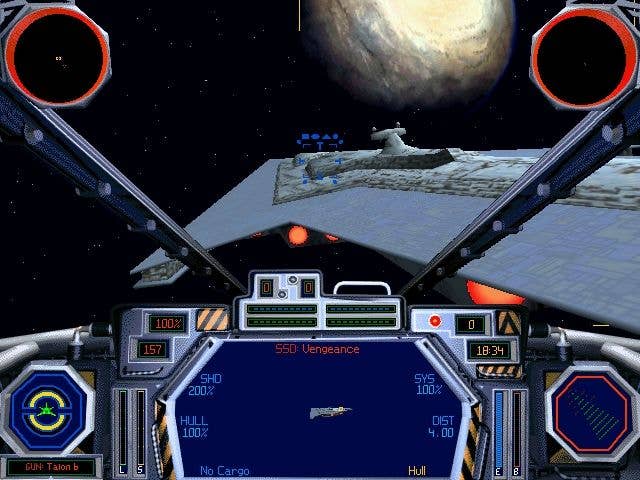
The Farlander Papers
Rusel DeMaria was the creative director at Prima Games when he was contacted with an interesting proposal. He was asked to write a novella for the forthcoming X-Wing game that would offer a bit of backstory while introducing gamers to the Star Wars universe.
DeMaria was thrilled. He told me over email, "Oh, I was a huge fan, especially of the first two films. I wasn’t as much of a fan of Return of the Jedi, but overall, I thought Star Wars was a great franchise and something I was thrilled to be able to be part of."
The story he developed starred Keyan Farlander—a Luke Skywalker-like figure who witnesses the destruction of his home at the hands of the Empire and decides to join the Rebellion. With Lucas out of the picture, DeMaria worked with Larry Holland and LucasArts' Lucy Wilson to flesh out the details of the story. At the time, the franchise backstory was still ill-defined, but what would become the prequels was visible in broad strokes in DeMaria's Farlander Papers: It refers to the aftermath of the Clone Wars and and the growing corruption of the Republic, as well as Palpatine's political maneuvering to become President of the Republic.
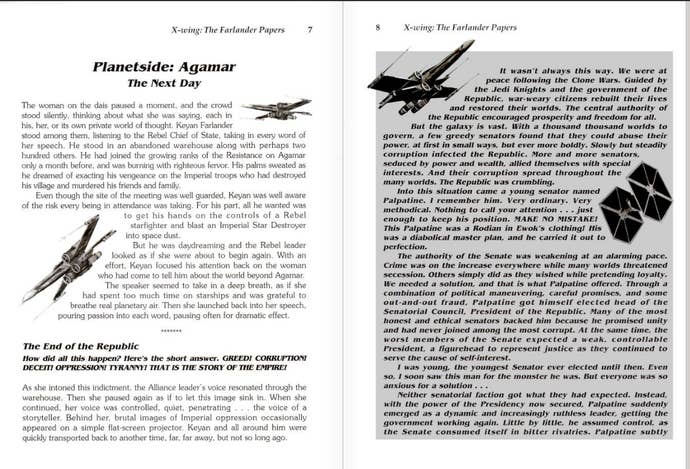
DeMaria was actually forbidden from filling in the details of the Clone Wars: one of the only limits imposed on X-Wing's writing team. "I was told that I could write anything I wanted, make up anything, as long as it didn’t involve the Clone Wars. Clone Wars was absolutely forbidden at the time. Everything else was fair game. And I did make up stuff. I gave certain races mannerisms that I just made up. I invented some alien foods for my characters to eat. Stuff like that. Everything was approved."
The novella ultimately wound up covering Farlander's introduction to the Rebellion, his training as an X-Wing pilot, and his first mission. Mixed within this novella were pamphlets describing the rise of the Empire, key characters like Admiral Ackbar, and starfighter technical specifications. It made for fascinating reading if you were a Star Wars fan in the early '90s without access to the materials that fill the Internet today.
DeMaria would next team up with David Maxwell and David Wessman to turn that novella into a hybrid strategy guide and Star Wars novel. Wessman remembers, "Rusel had a great rep as a game writer, and did a lot of strategy guide work. I wasn't aware of his creative writing side, so that was kind of a separate thing. He and I and David Maxwell ended up working very closely together because [DeMaria] was focusing on the fiction and wanted us to do the actual mission guide. So we wrote them as if it was a pilot giving an after action report, then I would take all of the material and do the proofreading/editing pass on it, then Rusel wrote the interstitial pieces."
The actual game was only a loosely connected with no real protagonist, so DeMaria set about filling in the gaps in the strategy guide with Farlander as the hero. The finished product was one of the more interesting strategy guides ever developed. The mission guides were pitched from Farlander's point of view, but the appropriate strategies were very much apparent. In-between, it followed Farlander as he lived the life of the pilot, and eventually began to dabble in the Force. DeMaria recalls, "The strategy guide includes all of the original novella and then continues his story as he learns to become an X-Wing pilot and then rises in the ranks through his experience in the missions. He has many adventures, makes friends with people I invented, and even has a short, but devastating brush with the Dark Side that forever changes his destiny. I had planned to write more stories about him, and would still like to do so if I could get permission. At one time, Dark Horse comics approached me about doing a series on him, and Lucas approved it. But then the guy who approached me just disappeared from Dark Horse and it was never pursued."
The strategy guide ended up selling very well (in part because X-Wing was famously difficult), and to one extent or other, Farlander managed to stick with the Expanded Universe. It became accepted canon, for instance, that Farlander was the one flying the lone surviving Y-wing that fled the exploding Death Star. Farlander also made an appearance in the later novels alongside Maarek Stele, another DeMaria creation from TIE Fighter, as well as Dark Force's Kyle Katarn.
But while DeMaria wanted to continue telling stories in the Star Wars universe, his own involvement with the franchise ended after TIE Fighter. "Technically, I was never on the X-Wing team. I was a contractor and the strat guides were done through Prima. But I guess I worked with them for a couple of years."
Still, DeMaria's stories would fill in the gaps for a generation of Star Wars fans. And while saying that they laid the groundwork for what was to come may be overstating their importance, they've nevertheless managed to stick in a way that is unprecedented for a strategy guide.

A New Era
In the years following X-Wing, the fiction of the Star Wars flight sims became progressively more involved. TIE Fighter prominently featured Thrawn—the popular villain from Timothy Zahn's Heir to the Empire trilogy. X-Wing vs. TIE Fighter initially dropped the single-player campaign in favor of multiplayer ("I am primarily to blame for the lack of story in [X-Wing vs. TIE Fighter] because I convinced myself and everyone else that we didn't really need it," Wessman admits), but rebounded with an expansion featuring campaigns from the perspective of both the Empire and the Rebellion. X-Wing Alliance concluded with a Shakespearean tale of two families in conflict that culminated in a run through the Death Star II in the Millennium Falcon.
By the time X-Wing Alliance came around, times had definitely changed. Promotion for Star Wars: The Phantom Menace was in full swing; and while Totally Games retained much of their creative freedom, they nevertheless ran into one rather large conflict. Wessman explains, "In [X-Wing Alliance], we had based a big chunk of the story around drone starfighters, and we didn't know anything about the content of Episode I. We just knew that our game had to be out before the movie was released. Then one day word comes down that [George Lucas] said, 'Yeah, you've gotta take out the stuff about drones.' And we were like, 'What? That's a huge part of the game that's already done.' And it came down to it that if we actually had to act on it we wouldn't meet our ship date, and that was more important, so George allowed us to keep our drones even though it was going to be something he was doing in Episode I. I guess we thought we were stealing their thunder... I don't know."
He continues, "The whole thing about X-Wing Alliance's ship date. It had to be out a couple months before the movie. If not, they were going to sit on it until September, which would have been really bad for us. Their logic was that New Star Wars shouldn't be confused with Classic Star Wars, and we don't want fans to be confused because there's a new movie and a classic game. So okay... fine. And I thought, at one point, because I had been wanting to do it for years, that I would be able to shoehorn in an RTS mode and... I almost made us miss our target date. I didn't do anything to cause that, but I thought about it."
Sadly, X-Wing's run was nearing an end. While X-Wing Alliance was successful and made money, the bottom fell out of the sales. No plans were made for an expansion or a sequel, much to the chagrin of fans hoping for a resolution to the Azzameen story. Both Star Wars and PC gaming were in a new phase, and the days of building freewheeling campaigns that defined large chunks of the franchise's backstory were over.
But to this day, X-Wing still resonates. Indeed, Disney may have hit the reset button, but there has yet to be a film about the anonymous Y-Wing pilot who makes it out of the Death Star. As far as I'm concerned, it's still Keyan Farlander.
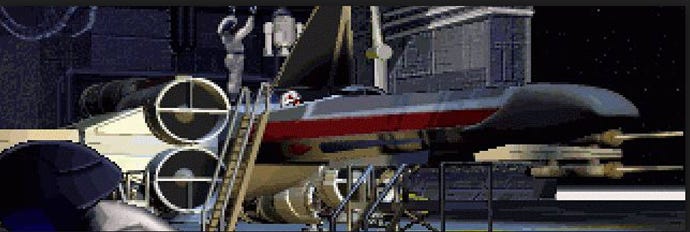

.jpg?width=291&height=164&fit=crop&quality=80&format=jpg&auto=webp)
.jpg?width=291&height=164&fit=crop&quality=80&format=jpg&auto=webp)

